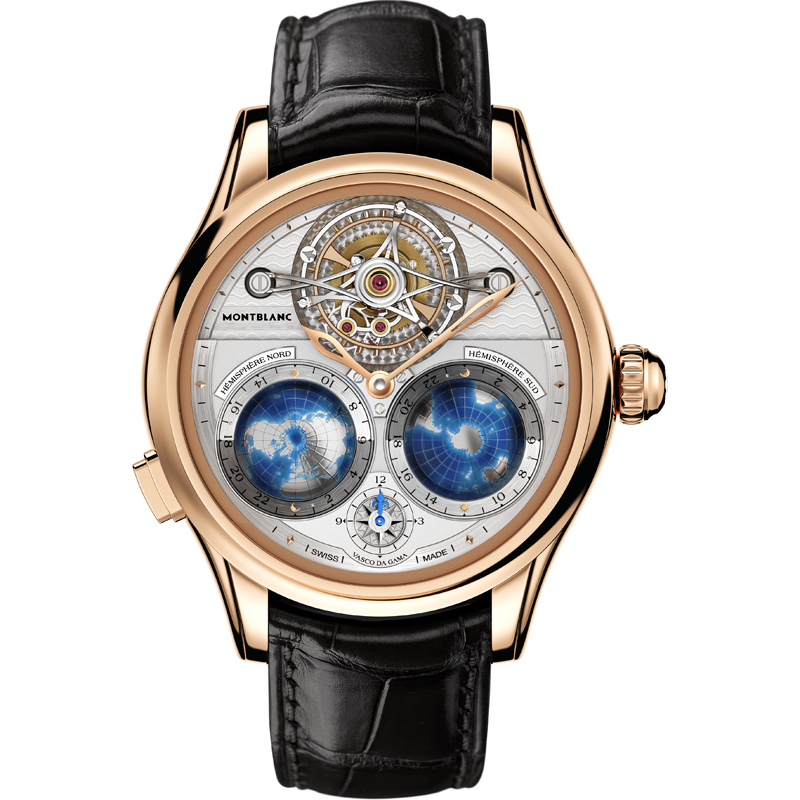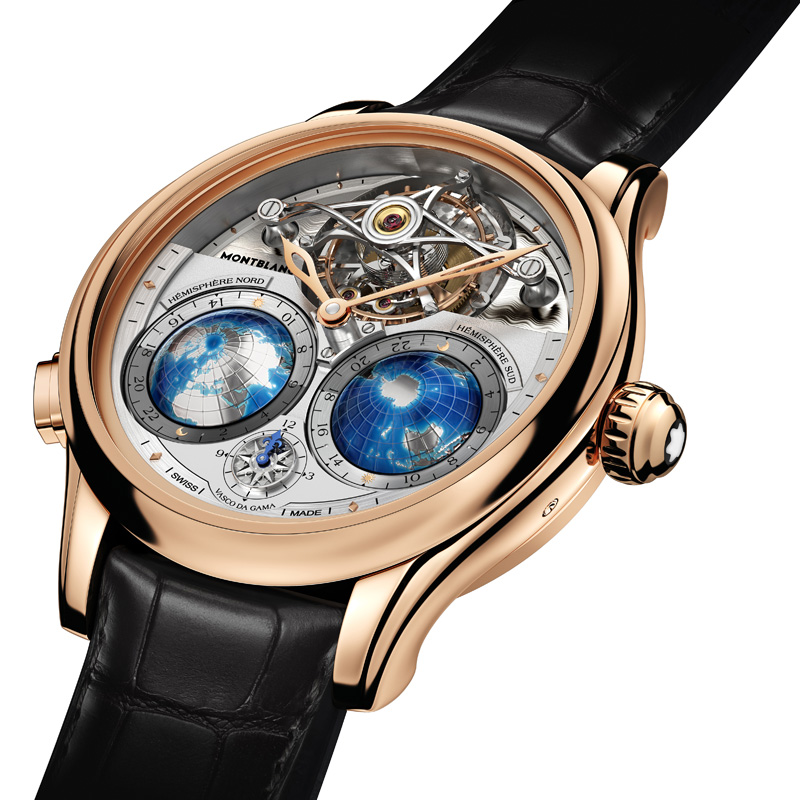
Villeret Tourbillon Cylindrique Geosphères Vasco da Gama - Limited Edition 18
Power reserve: 48 h, 18000 vph
Montblanc Villeret Tourbillon Cylindrique Geosphères Vasco da Gama Limited Edition 18
A Voyage into Unchartered Territories of the Watchmaking World
Uninterrupted and unique artisanal production in strict accordance with traditional Swiss craftsmanship distinguishes Montblanc’s Manufacture in Villeret. Scarcely anywhere else on Earth is impassioned craftsmanship pursued as single-mindedly as it is at the Manufacture in the St. Imier Valley. Since 1858, the valley’s artisanal watchmakers have created elaborate mechanical movements from components that they personally craft step by painstaking step until achieving the highest quality and the ultimate refinement.
Now their voyage into uncharted territories of the watchmaking world continues with the Montblanc Villeret Tourbillon Cylindrique Geosphères Vasco da Gama Limited Edition 18, a timepiece with the unprecedented combination of a cylindrical tourbillon and unique triple time zone indication. Strictly limited to eighteen pieces, the Montblanc Villeret Tourbillon Cylindrique Geosphères Vasco da Gama Limited Edition 18 is a revolutionary wristwatch that pushes the boundaries of fine watchmaking with the utmost performance and spectacular artisanal beauty.
Montblanc Tourbillon Cylindrique Geosphères Vasco da Gama Limited Edition 18
For many years, Montblanc and its Manufacture in Villeret have presented unique timepieces that express the comprehensive skills of the artisans at this time-honoured Manufacture. Now the developers and watchmakers have once again employed all their expertise to create a wristwatch that is quite literally the ticking “flagship” of the new Montblanc Vasco da Gama watch collection. It was Vasco da Gama’s urge to discover new worlds and his unwavering courage that inspired Montblanc and spurred the Manufacture’s watchmakers to achieve superlative horological feats.
Far more than merely a complicated wristwatch, the Montblanc Villeret Tourbillon Cylindrique Geosphères Vasco da Gama Limited Edition 18 also performs an unconventional horological performance. The 47-mm-diameter case surrounds a three-dimensional dial that positively invites admiring scrutiny. The 281 components that comprise hand-wound tourbillon Calibre MB M68.40 support numerous functions in an unprecedented combination: a triple time zone with local time is displayed in the form of hours and minutes; the continually running and independently adjustable display for the home time is presented on a three-dimensional twelve-hour compass rose at “6 o’clock”; and a pair of globes depict the World´s 24 time zones in the Northern and Southern Hemisphere, along with the passage of the days and nights. Engraving and miniature painting on these two halved balls indicate in relief the outlines of the continents, their borders and the oceans that separate them. The passage of time accordingly becomes an impressive and daily recurring spectacle on the wearer’s wrist and recalls the sea route through the Earth’s two hemispheres that Vasco da Gama sailed in 1497.
The Dial
The 18-karat gold dial is constructed in various parts and on different levels. Inspired by the twin distinctive globes, Montblanc’s designers relied on round shapes and rounded décor. The upper part of the dial is the stage for the tourbillon with its arcing, convex, polished tourbillon bridge. The guilloché embellishment is crafted accordingly: manually executed guilloché, which adorns the components to the left and to the right of the tourbillon mechanism, is applied in a wavy décor inspired by Vasco da Gama’s voyage across the world’s oceans. The lower portion of the dial is the arena for the two globes and the home-time indication in the form of a three-dimensional compass rose. The hand that sweeps above this rose to indicate the hours is likewise styled in a “Fleur-de-Lys” shape.
The Tourbillon
Montblanc developed the 281-part hand-wound Calibre MB M68.40 featuring a 91-part tourbillon mechanism with a cylindrical hairspring which guarantees a power reserve of 48 hours. The balance’s frequency is 18,000 semi-oscillations per hour (2.5 hertz). Thanks to its 14.5-mm diameter, the balance’s moment of inertia is an 59 mgcm². Few manufactures nowadays employ artisans with the necessary know-how and craftsmanly skills to fabricate their own balance wheels and hairsprings. Without these abilities, Montblanc could never have developed the cylindrical hairspring for the Montblanc Villeret Tourbillon Cylindrique Geosphères Vasco da Gama Limited Edition 18.
Unlike their flat counterparts, cylindrical hairsprings were regarded as the summum bonum and installed only in the finest and costliest marine chronometers. Valuable ship’s chronometers were indispensable for seafarers because only with the aid of a clock that continued to show the correct time with great accuracy for a lengthy period of time were mariners able to determine their longitude on the high seas. Today too, a cylindrical hairspring continues to embody the utmost precision. Like a conventional balance-spring, a cylindrical balance-spring is a concentrically wound strip of elastic metal; however instead of being wound side by side, at increasing distances from a common centre and all on the same plane, its individual turns are all of equal diameter and are wound one atop the other. This eliminates the slight eccentricity of the centre of gravity, which has always been the Achille’s heel of conventional balance-spring. The challenges for Montblanc’s watchmakers were to miniaturize this type of hairspring and to install it in the tourbillon mechanism of a wristwatch. The extremely high degree of in-house fabrication at the Montblanc Manufacture in Villeret, combined with the expertise accumulated here over many years, enabled these specialists to create more than merely a “simple” cylindrical hairspring, but to further equip it with two Phillips terminal curves. The upward curvature at each end of the spiral contributes toward significantly improving the regularity of the hairspring’s “breathing,” thus further reducing the isochronism error. Montblanc accordingly achieved for this masterpiece a highly accurate rate.
Incomparable beauty distinguishes the styling of the doubly curved, three-dimensional, endless loop of the tourbillon bridge, beneath which the tourbillon’s large cage completes one rotation around its own axis every sixty seconds.
For the Montblanc Villeret Tourbillon Cylindrique Geosphères Vasco da Gama Limited Edition 18, Montblanc’s typical tourbillon bridge departs for the first time from its usual planar shape and acquires a convex form. It thus perfectly harmonizes with the two globes on the dial. A master watchmaker requires more than seven days to entirely handcraft this distinctive tourbillon bridge and to give it an absolutely immaculate polished finish.
The Operation
The indicators on the Montblanc Villeret Tourbillon Cylindrique Geosphères Vasco da Gama Limited Edition 18 can be set via the crown, the visible pusher at “8 o’clock” and the inset corrector on the case’s flank at “4 o’clock”. After pulling the crown outward, the user can set the local time and simultaneously adjust the worldtime display along the two globes’ 24-hour scales. The corresponding buttons on the case are used to finely adjust the local time in the centre and the home time on the compass rose at “6 o’clock”, which runs along with the local time. Once all indicators have been correctly synchronized, a new local time in a different time zone can be set simply by pressing the push-piece at “8 o’clock”. Operating this pusher advances only the hour-hand in single-hour increments; it does not affect the minutes, which are shown from the dial’s centre, nor does it alter the home time at “6 o’clock” or the two displays along the globes. When the watch’s owner is travelling, he or she can conveniently read the local time by referring to the hour- and minute-hand in the centre, check the home time at “6 o’clock” and see the hour anywhere else in the world by referring to one of the two 24-hour discs around the globes.



